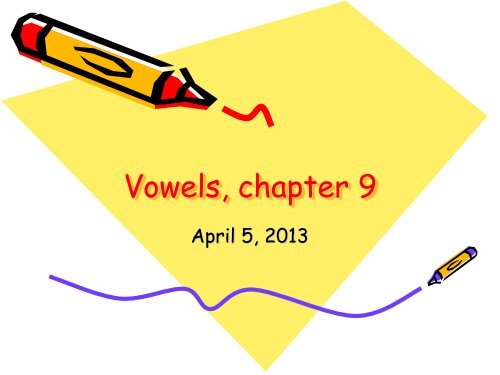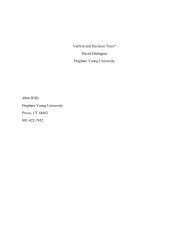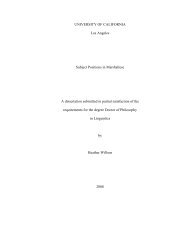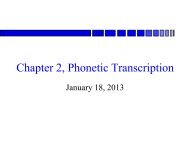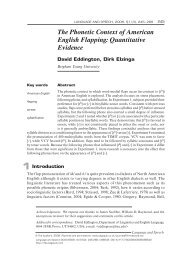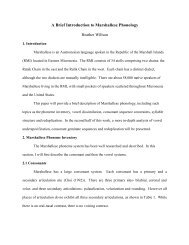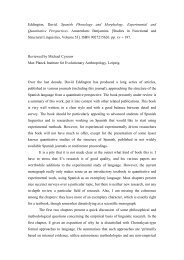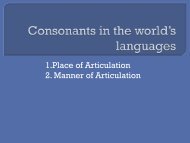Vowels, chapter 9 - Department of Linguistics and English Language
Vowels, chapter 9 - Department of Linguistics and English Language
Vowels, chapter 9 - Department of Linguistics and English Language
You also want an ePaper? Increase the reach of your titles
YUMPU automatically turns print PDFs into web optimized ePapers that Google loves.
<strong>Vowels</strong>, <strong>chapter</strong> 9<br />
April 5, 2013
Quiz<br />
1. Who is Daniel Jones?<br />
2. What are cardinal vowels?<br />
3. How do primary cardinal vowels<br />
differ from secondary cardinal<br />
vowel?<br />
4. What is the principle <strong>of</strong> perceptual<br />
separation?
. Principle <strong>of</strong> Balance<br />
Definition: If a<br />
language has one<br />
sound in its<br />
inventory, it will<br />
usually have a<br />
similar sound<br />
across the vowel<br />
chart<br />
Example: Think <strong>of</strong> the languages you have<br />
been examining in your investigations—if they<br />
have an /i/ do they have an /u/? If they have an<br />
/e/ do they have an /o/? Any exceptions?
6. Why are cardinal vowels<br />
used?<br />
To explain the exact pronunciation <strong>of</strong> a vowel<br />
Example: French /y/, <strong>English</strong> /u/ <strong>and</strong> French<br />
/u/<br />
French /y/ <strong>and</strong> /u/ are very close to cardinal<br />
vowels, <strong>English</strong> /u/ is more centralized,<br />
closer in perception to Cardinal vowel /y/
Vowel Charts <strong>of</strong><br />
<strong>Language</strong>s <strong>and</strong> Dialects<br />
Look over the charts <strong>of</strong> different<br />
vowel systems.<br />
1. Can you find the principle <strong>of</strong><br />
perceptual separation?<br />
2. Can you find the principle <strong>of</strong><br />
balance?<br />
3. Are there any exceptions?
How do we get 300<br />
vowels?<br />
• <strong>Vowels</strong> can be distinguished not only in terms <strong>of</strong> their<br />
quality (the value <strong>of</strong> their formants), but also by<br />
primary <strong>and</strong> secondary articulations <strong>and</strong> by the type<br />
<strong>of</strong> phonation used for their production; e.g.<br />
• Gujarati has breathy voiced vowels<br />
• Mazatec has creaky-voiced vowels<br />
• Mpi has tense-voice vowels<br />
• When phonation types are combined with vowel<br />
height, backness, rounding <strong>and</strong> nasalization the<br />
number <strong>of</strong> possible vowels increases dramatically
<strong>Vowels</strong> <strong>and</strong> Primary <strong>and</strong><br />
Secondary Articulation<br />
Primary Articuation:<br />
• Rhoticized<br />
• Nasalized<br />
• ATR<br />
• Semivowels<br />
Secondary Articulation<br />
• Palatalization<br />
• Velarization<br />
• Pharyngealization<br />
• Labialization
1. What are Rhotic<br />
<strong>Vowels</strong>?<br />
What is the tongue shaped like in a<br />
rhotic?<br />
It’s either bunched in the center <strong>of</strong><br />
the mouth or the tip is retr<strong>of</strong>lexed<br />
back in post-alveolar<br />
What do F2 <strong>and</strong> F3 look like in rhotic<br />
vowels?<br />
F3 (<strong>and</strong> sometimes F2) bend down.
Rhotic <strong>Vowels</strong>
Is there a difference<br />
between /ar/ <strong>and</strong> /r/?<br />
/ar/ has a part <strong>of</strong> a vowel that is nonrhotacized<br />
(the first part). / r/ only<br />
has a rhotacized vowel (notice where the<br />
3 rd formant originates)<br />
This is why r is sometimes transcribed<br />
as // or //.
R-coloring in Am E<br />
Merry, Mary, Marry<br />
Bird, bert<br />
But in Scottish <strong>English</strong>, /r/ doesn’t<br />
influence vowel quality like it does in<br />
Am Eng<br />
Bird vs. bert
2. What are Nasalized<br />
If velum is lowered<br />
slightly to let part<br />
<strong>of</strong> the air through<br />
the nasal cavity, a<br />
vowel will be<br />
nasalized.<br />
The amount the<br />
velum is lowered<br />
determines the<br />
degree <strong>of</strong><br />
nasality.<br />
<strong>Vowels</strong>?
Ladefoged<br />
2001<br />
Nasalized<br />
vowels<br />
<strong>of</strong>ten show<br />
weaker<br />
formants<br />
<strong>and</strong> a<br />
smaller<br />
separation<br />
<strong>of</strong> first <strong>and</strong><br />
second<br />
formants<br />
Examples <strong>of</strong> nasalized vowels in American <strong>English</strong>
Manyah, 2009: <strong>Vowels</strong> <strong>of</strong> Twi
French Nasal <strong>Vowels</strong>
American “Nasal” <strong>Vowels</strong>
Contextual nasalization<br />
• In most languages, vowels are nasalized (to<br />
an extent) before/after nasal consonants;<br />
American <strong>English</strong> is a language is which<br />
such non-contrastive nasalization is quite<br />
extensive<br />
• In French, vowels can also be contextually<br />
nasalized when they occur between nasal<br />
consonants, but the degree <strong>of</strong> nasal airflow<br />
is not as strong as in a nasal vowel:<br />
bo.nnet oral [bnEt]<br />
no.nnette slightly nasal [nnEt]<br />
non-être fully nasal [n)nEt]
Nasalization<br />
Nasal airflow is measured with a nasal mask:<br />
Oral vowel<br />
Contextually<br />
nasalized<br />
vowel<br />
‘real’ nasalized vowel
Some languages distinguish<br />
between these three degrees <strong>of</strong><br />
nasalization: non-nasalized,<br />
partially nasalized, <strong>and</strong> nasalized
Spectrogram <strong>of</strong><br />
Chinantec


